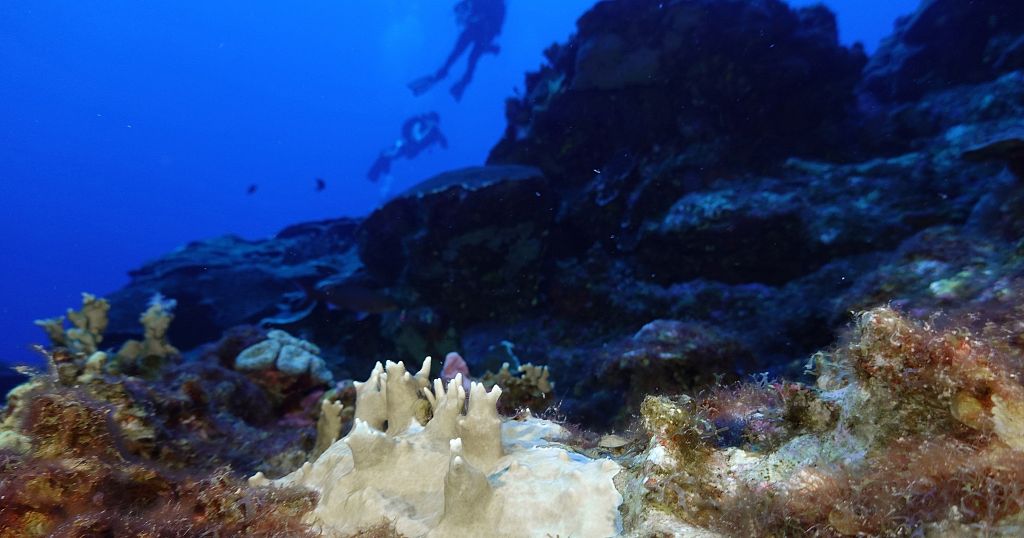The National Oceanic and Atmospheric Administration (NOAA) and international partners have declared the fourth global mass coral bleaching event, a catastrophe causing damage on coral reefs worldwide. This event by record-breaking ocean heat has an existential threat to marine ecosystems and the billions of lives they sustain.

Also Read: Afghanistan Floods: 33 Killed, 27 Injured and 600 Houses Damaged
According to NOAA’s Coral Reef Watch program, as 54% of ocean waters hosting coral reefs have experienced heat stress levels conducive to coral bleaching.
This figure underlines the nature of the crisis, transcending geographical boundaries and impacting reefs across all major ocean basins, the Pacific, Atlantic, and Indian.
The Coral bleaching event which commenced in early 2023, has exhibited a escalating severity. Dr. Derek Manzello, the Coral Reef Watch director, warns that the percentage of affected reef areas is increasing by approximately 1% per week, a march towards ecological collapse.
From the initial event in 1998, affecting 20% of the world’s reef areas, to the subsequent crises in 2010 (35%) and 2014-2017 (56%). The wrought by coral bleaching transcends geographical boundaries sparing no corner of the globe.
Mass Coral bleaching has been confirmed in diverse locales, including Florida, the Caribbean, Brazil, the South Pacific, the Middle East, and the Western Indian Ocean, encompassing countries such as Tanzania, Kenya, Mauritius, and Indonesia.
Australia’s crown jewel, the Great Barrier Reef, stands at the epicenter of the crisis, struggling with its most severe bleaching event on record.
Aerial surveys reveal that approximately 80% of the reef exhibited bleaching-level heat stress in 2024, surpassing previous highs.
Renowned coral researchers including Prof. Ove Hoegh-Guldberg, address the urgent need for concerted global action to mitigate the crisis. With climate models projecting severe, annual bleaching events for every reef by 2040-2050.
Coral bleaching carries economic implications imperiling industries reliant on reef ecosystems. Coral reefs, valued at a $2.7 trillion annually.
Also Read: Storm Kathleen: 70 Flights Cancelled as Storm Hits UK
The U.S. National Oceanic and Atmospheric Administration (NOAA) confirms the onset of the fourth global mass coral bleaching event, affecting coral reefs across all major ocean basins, the Atlantic, Pacific, and Indian Ocean.
Ocean heat records have been consistently, with the global average ocean temperature hitting an all-time high last August.
Climate change driven by greenhouse gas emissions is the primary driver behind rising sea surface temperatures.
El Niño a natural climate phenomenon has exacerbated the warming trend since last June further stressing coral reefs globally.
Coral bleaching a phenomenon where stressed corals expel their symbiotic algae and turn white is a visible indicator of the distress reefs face.
Scientists report bleaching in iconic reef systems such as Australia’s Great Barrier Reef, the Caribbean, Tanzania, Mauritius, Brazil, and the Red Sea.
Coral bleaching not only threatens the structural integrity of reefs but also disrupts marine ecosystems, jeopardizing fish populations and the livelihoods of fishing communities.
Researchers warn that coral reefs are approaching their thermal limits with stressed corals facing mortality if temperatures exceed 1°C above normal for prolonged periods.
While some corals in deeper, cooler waters show resilience to heat stress, the overall prognosis for coral reefs remains bleak.
NOAA predicts that without urgent action to curb greenhouse gas emissions, severe annual bleaching events could afflict every reef on the planet by 2040-2050.
Also Read: Russia Floods: Thousands Evacuated as Dam Bursts in Orenburg Region






















